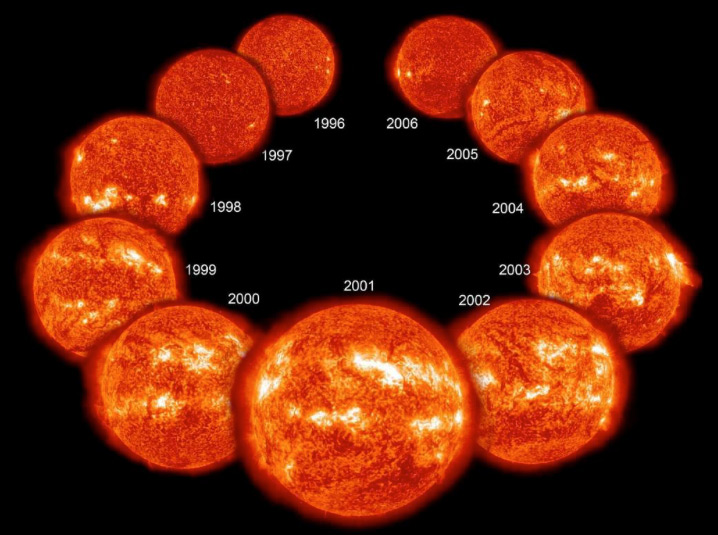The sun is without any spots today, and it seems we have had no spots for more than a week!
In mid-February 2018, solar activity was as low as 2007 levels, which was one year before that solar minimum began. That’s why solar physicists now project that the Solar Cycle 24 minimum leading up to Solar Cycle 25 will begin a year from now in the spring of 2019.
Some solar physicists have even placed bets about whether low energy Solar Cycle 24 will keep extending into Solar Cycles 25 to 26 ending up in a Maunder Minimum of 1645 to 1715, when our Sun was blank without sunspots most of the time and coincided with a Little Ice Age.
Why would lack of sunspots cause Earth to get colder? Sunspots result from magnetic activity inside the Sun. Paradoxically, as spots on the Sun get darker and cooler, the areas around sunspots brighten up. So the more sunspots, the more solar energy reaches Earth. But why would we have a Maunder Minimum now in the 21st Century?
A couple of years ago in the summer of 2015, the Royal Astronomical Society had Professor Valentina Zharkova speak about her computer solar cycle model that analyzes magnetic wave components in our Sun. She discovered the waves appear in pairs at two different layers of the Sun’s interior.She explained, “They both have a frequency of approximately 11 years, although this frequency is slightly different, and they are offset in time. Over the cycle, the waves fluctuate between the northern and southern hemispheres of the Sun. When you combine both waves together and compare to real data for the current solar cycle, we found that our predictions showed an accuracy of 97%.”
Projecting their data to the next Solar Cycle 25, which is supposed to peak in 2022, the two waves will become exactly out of sync, countering each other, and that is expected to significantly reduce sunspots and solar activity.
Then the projection for Solar Cycle 26 is that “the two waves will exactly mirror each other, peaking at the same time, but in opposite hemispheres of the Sun. Their interaction will be disruptive, or they will nearly cancel each other out. We predict that this will lead to the properties of a Maunder Minimum. When there is full phase separation, we have the conditions last seen only during the Maunder minimum some 370 years ago.”
Our Sun Was Blank 25% of 2017 — Dangerous Increase in Cosmic Rays
In 2017, the sun was completely blank 25% of the year as that Solar Cycle 24 was historically weak with probably the lowest number of sunspots since 112 years ago in the Solar Cycle 14 of 1906. Current 2018 computer models project that from the upcoming Solar Cycle 24 minimum out to Solar Cycle 26 expected to start around 2030, the Sun’s solar output could be even weaker, taking the Sun down to a level of weak solar output not seen since the cold years of the Dalton Minimum in 1790 to 1830, and maybe even the Maunder Minimum that European scientists linked to the Little Ice Age. Others have argued that the huge 1815 eruption of Mount Tambora in Indonesia might have caused Earth cooling.
Weakening Magnetic Fields Means More Dangerous Cosmic Rays Reach Earth
Last month on February 22nd, 2018, the Space Weather Journal published an “Update on the worsening particle radiation environment now observed and implications for future human deep-space exploration.” The lead author is Nathan Schwadron, Ph.D., a physicist in the University of New Hampshire Space Science Center who also does work for the Solar System Exploration Research Virtual Institute at NASA Ames Research Center in Moffett Field, California. He warns in his new research that cosmic rays in the Earth-Moon system have been peaking at levels never seen before in the modern Space Age. The increasing cosmic rays can hurt astronauts.
Professor Schwadron writes: “Over the last decade, the solar wind has exhibited low densities and magnetic field strengths, representing anomalous states that have never been observed during the Space Age. As a result of this remarkably weak solar activity, we have also observed the highest fluxes of cosmic rays.”

NASA has limits about how much cosmic radiation is safe for astronauts. But with the declining sunspots as we move toward Solar Cycle Minimum 24, if solar activity continues to decrease, Prof. Schwadron and his colleagues report that a leading computer model of solar activity to predict how bad cosmic rays would become during the next Solar Cycle 24 Minimum, now expected in 2019-2020, suggests a 20% increase of dose rates from one solar minimum to the next. In fact, we now see that actual dose rates observed in the last 4 years exceed the predictions by ~ 10%, showing that the radiation environment is worsening even more rapidly than we expected.”
Protecting astronauts from cosmic radiation is one of the key challenges facing future missions to Mars. NASA is even considering the use of drugs on Martian crews that will alter the DNA code of those people. The goal would be to alter those human bodies in such a way that the altered DNA would repair any damage sustained from cosmic rays that could cause cancer and other diseases.NASA Spaceweather reports: “Cosmic rays also penetrate commercial airlines, dosing passengers and flight crews so much that pilots are classified by the International Commission on Radiological Protection as occupational radiation workers. Some research shows that cosmic rays can seed clouds and trigger lightning, potentially altering weather and climate. Furthermore, there are studies that link cosmic rays to cardiac arrhythmias in the general population.”
Bottom line: if our Sun is headed for a lot more blank days without sunspots, for certain cosmic rays will intensify even more in the years ahead as it evolves toward what could be the deepest Solar Minimum in more than a century.









No comments :
Post a Comment